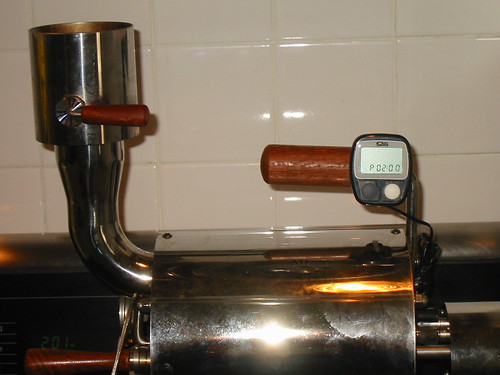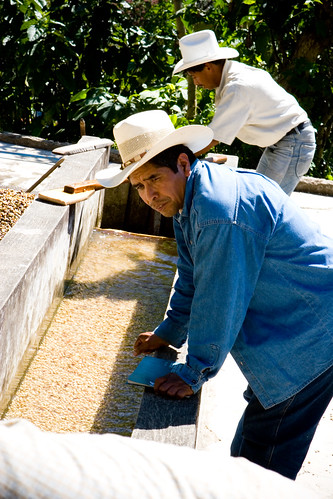 originally uploaded by yehwan.
originally uploaded by yehwan.Scones are something I wasn't really aware of until I moved to Cambridge. Not a big thing in the South, I guess. Finding a great scone though seems to be a harder thing than most give credit. Finding quality baked goods or pastries in a top cafe in general seems to be a difficult proposition. Most of the high end or famous (on the Internet) cafes I have visited carry pretty blase or pitiful food accompaniments to the coffees offered. It's a shame and I would go to great length to have good scones and great coffees in the same shop. Why not?
When I first started working at Simon's, long ago, I was introduced to scones. A lot of scones in fact, but they were like dense bricks whose only saving grace was a slathering of sugary icing on top or heavy amounts of chocolate to sweeten the tasteless lump. Carberries scones, which though once very popular, lacked redeeming character and were not something any of us behind the counter wanted to eat. Those scones were however the most commonly served in town since Icelandic(I think) investors came in and turned Carberries into a factory type deal. Baked at night and delivered in the morning, they were already tasting day old by that point.
I decided to make it a priority as soon as I could get enough influence. Once I convinced Simon to audition new pastries, the problem began to be simply who? There were options but not a lot of good options out there.
Petsie Pies is a wonderful bakery about a 10 minute walk from Simon's. Baked goods only, scones and fruit pies that have a home style feel and great texture to them. So, I found the owner, Renee and struck up a proposition. Renee is a smiling boisterous person with a great demeanor and a charm that brightens a room. We wanted those scones. We decided to bake them from the dough and we would even come pick them up if we had to. All they had to do was mix it and have it ready. After some discussion, Renee relented and promised to work something out.
Weeks passed and no call, nothing. We were jilted but the scones were good, so I made another trip over. Renee apologized and we discussed more options ending with a promise that we would get scones.
A month passed and no call, nothing. I was annoyed but the scones were good, so I made another trip over. Renee again apologized and we opened discussions again to get those scones.
Time passed and no call, nothing. I did not wait this time before going back again to check with Simon in tow. We all agreed the scones were good but we needed to commit one way or another if this was going to be a reliable situation. Mind you those scones were good.
The summer was ending and much time passed with no scones, no call, no nothing. I made one more trip, because.... those scones were good. One last trip, I told myself and that would be the end of it. I caught Renee for a chat where I professed my situation and commitment to get something done having spent so much time on this venture. If there was a better choice, I would have been there but this was worth the effort I kept telling myself. Renee professed she wanted to do this. She convinced us this time she was serious. I told her one day I would stop coming to which she replied, one day I would stop coming and she would have missed this chance. Famous last words, I thought.
To my surprise, a few days later she dropped by Simon's for a drink. Not too long afterwards, we finally had those scones. For months, we had these great scones, scones I wanted to eat, scones I would push customers to try. Then one weekend, no more scones.
Turns out Gus 'Stick to Ice Cream' Rancatore (
Toscanini's) put in a very large order with Renee for scones. Now Gus already had a binding deal with one of his partners to only use their scones so this came out of left field to us. Evidently, Renee couldn't handle the order and dropped selling us all scones as a result. There would be no follow up trip for me, I was done on this journey for a better scone.
If you drop by one of the locations for Petsie Pies and see Renee, say hello and pass along this story for me. Good scones are hard to find, maybe a bit too hard to keep. Most people will never understand how hard it is to accomplish little feats in quality much less great steps. How easy it is to give up but
those who are not content can achieve great things, if only for a moment in time.






